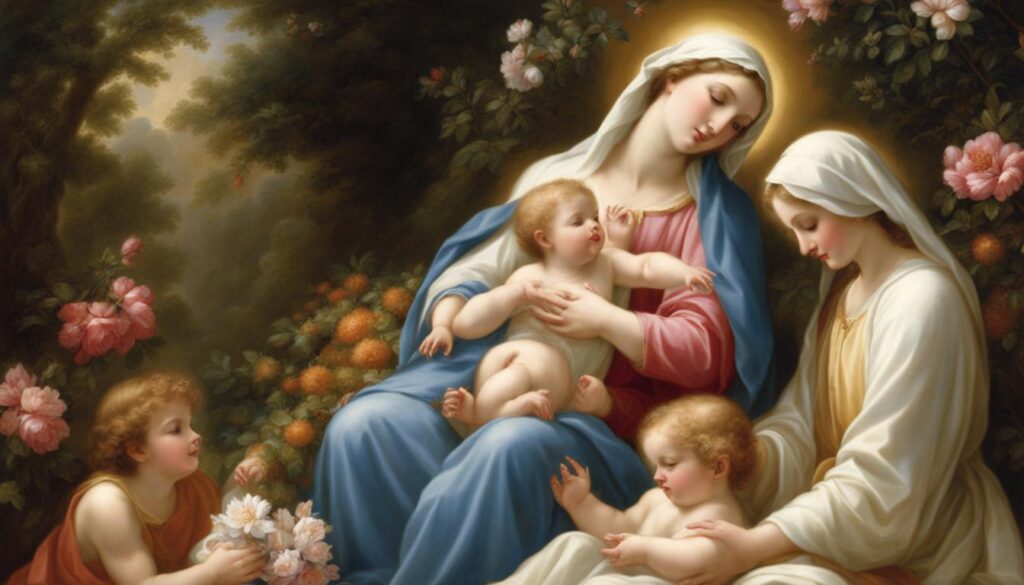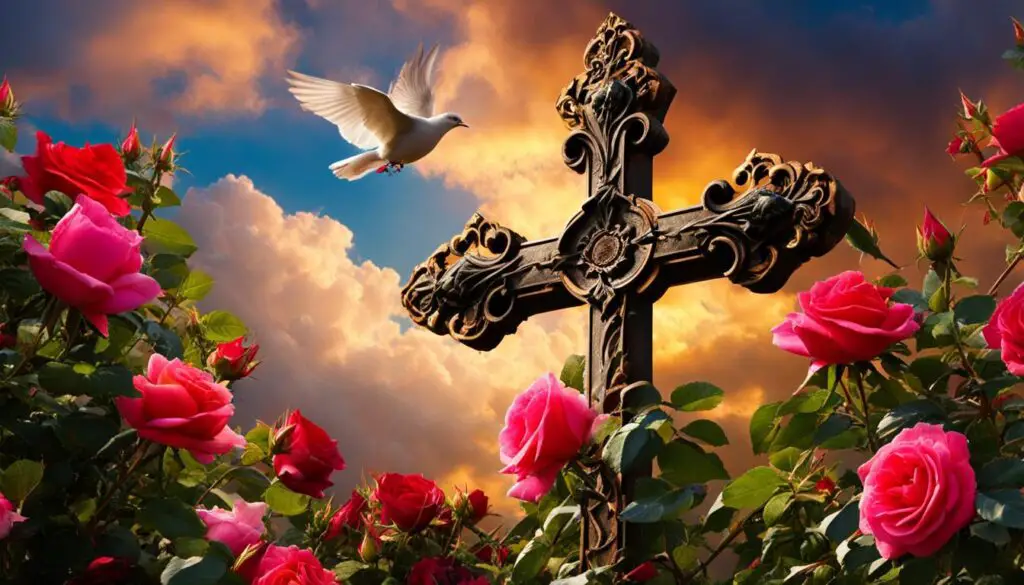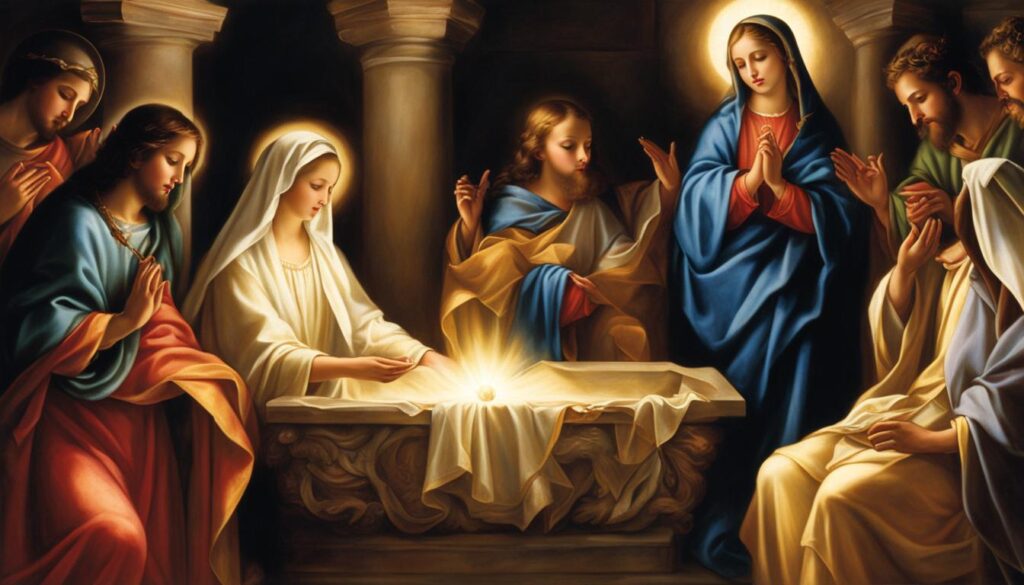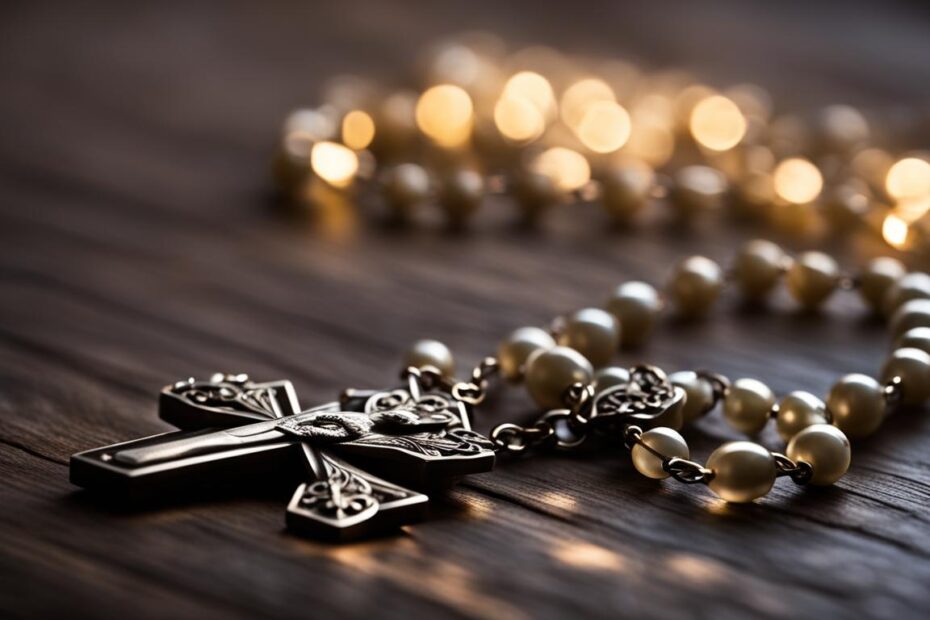The Rosary, also known as Catholic prayer beads, is a powerful tool for deepening one’s spiritual life and experiencing a profound connection with Jesus and Mary. This ancient prayer practice involves using beads to guide individuals through prayers and meditations on different mysteries of the Catholic faith. The Rosary is a cherished tradition in Marian devotion and holds great significance for Catholics around the world.
Through the Rosary, individuals have the opportunity to reflect on the life, ministry, death, and resurrection of Jesus Christ. The Rosary is divided into four sets of mysteries: Joyful, Sorrowful, Glorious, and Luminous. Each set of mysteries offers a unique opportunity to contemplate the profound moments in Jesus’ life and the role of his mother, Mary, in God’s plan of salvation.
As a Catholic prayer practice, the Rosary holds deep symbolism. The beads serve as a tactile aid, allowing individuals to count their prayers and remain focused on their meditation. The repetition of prayers, such as the Our Father and Hail Mary, creates a rhythmic and meditative experience that helps individuals enter into a state of prayerful contemplation.
Over time, variations have emerged in the way different sects and individuals practice the Rosary. While the structure and essential prayers remain the same, there may be slight differences in the order of the mysteries or additional prayers included. These variations reflect the diversity within the Catholic faith while maintaining the core essence of the Rosary.
The materials used for Rosary beads have also evolved throughout history. Traditionally, Rosaries were made from materials such as wood, precious metals, or gemstones. Today, there are countless variations of Rosary beads, including those made from materials like glass, crystal, or even plastic. The choice of materials often reflects personal preferences and cultural traditions.
Key Takeaways:
- The Rosary is a powerful form of prayer that allows individuals to deepen their spiritual life and connect with Jesus on a personal level.
- It involves using beads to guide individuals through prayers and meditations on different mysteries of the Catholic faith.
- The Rosary is divided into four sets of mysteries: Joyful, Sorrowful, Glorious, and Luminous.
- Practicing the Rosary involves repeating specific prayers, such as the Our Father and Hail Mary, while reflecting on the mysteries.
- Materials used for Rosary beads vary and can include wood, metals, gemstones, glass, crystal, or plastic.
What Are the Mysteries of the Rosary?
The mysteries of the Rosary are an essential aspect of this Catholic prayer practice. They provide a framework for meditation and reflection on significant events in the lives of Jesus and Mary. The mysteries are divided into four categories: Joyful, Sorrowful, Glorious, and Luminous. Each category consists of five different scriptural events, allowing individuals to delve deeper into the Catholic faith and develop a closer relationship with God.
Joyful Mysteries: These mysteries focus on the joyful events surrounding the birth and early life of Jesus and Mary. They include the Annunciation, Visitation, Nativity, Presentation, and the Finding of the Child Jesus in the Temple. Through these mysteries, individuals reflect on the miraculous conception of Jesus, Mary’s role as the mother of God, and the joys experienced by the Holy Family.
Sorrowful Mysteries: The Sorrowful Mysteries center on the suffering and death of Jesus. They include the Agony in the Garden, Scourging at the Pillar, Crowning with Thorns, Carrying of the Cross, and the Crucifixion and Death. Meditating on these mysteries allows individuals to contemplate on Jesus’ sacrifice and the immense love he showed for humanity.
Glorious Mysteries: The Glorious Mysteries focus on the events following Jesus’ resurrection. They consist of the Resurrection, Ascension, Descent of the Holy Spirit, Assumption of Mary, and the Coronation of Mary. These mysteries invite individuals to reflect on the hope and eternal glory brought about by Jesus’ triumph over death and Mary’s exaltation in heaven.
Luminous Mysteries: The Luminous Mysteries were introduced by Pope John Paul II and emphasize key moments from Jesus’ public ministry. They include the Baptism of Jesus, Miracle at Cana, Proclamation of the Kingdom, Transfiguration, and the Institution of the Eucharist. By meditating on these mysteries, individuals can gain a deeper understanding of Jesus’ teachings and the significance of the sacraments in their spiritual lives.
The mysteries of the Rosary provide a rich opportunity for scripture reflection and meditation. Each mystery encapsulates a unique aspect of the Catholic faith, offering individuals a path to spiritual growth and a deeper connection with God. Whether it’s contemplating the joy, sorrow, glory, or luminosity of Jesus and Mary’s lives, the mysteries of the Rosary invite believers to embark on a sacred journey of faith and devotion.
How to Pray the Mysteries of the Rosary
Praying the Rosary is a cherished Catholic prayer practice that involves a structured set of prayers and reflections. It provides a tangible way for individuals to engage in meditative prayer and deepen their connection with God and Mary. The Rosary is typically divided into five decades, each focusing on a different mystery related to the life of Jesus and Mary. By following a specific guide, individuals can engage in a meaningful and transformative prayer experience.
Praying the Rosary: Step-by-Step Guide
To begin praying the Rosary, first hold the crucifix and make the Sign of the Cross. Then, recite the Apostles’ Creed. Move on to the first bead (the Our Father bead) and say the Our Father prayer. This is followed by three Hail Mary prayers, one each for an increase in faith, hope, and love. On the next bead, announce the first mystery and recite the Our Father prayer.
Now, move to each of the ten beads and say a Hail Mary on each one. As you say each Hail Mary, focus on meditating on the mystery associated with that decade. After completing the ten Hail Marys, move on to the next bead (the Glory Be bead) and recite the Glory Be prayer, followed by the Fatima Prayer: “Oh my Jesus, forgive us our sins, save us from the fires of hell, and lead all souls to Heaven, especially those in most need of Thy mercy.”
Repeat this process for each of the five decades, meditating on the different mysteries. After completing the final decade, recite the Hail Holy Queen prayer to conclude the Rosary. Some individuals also choose to include additional prayers or intentions at the end. It’s important to note that there are variations in how the Rosary is prayed among different Catholic communities, but this general guide provides a solid foundation for engaging in this sacred prayer practice.
| Prayer | Number of Times Recited |
|---|---|
| Sign of the Cross | 1 |
| Apostles’ Creed | 1 |
| Our Father | 1 |
| Hail Mary | 10 (per decade) |
| Glory Be | 1 |
| Fatima Prayer | 1 |
| Hail Holy Queen | 1 |
Praying the Rosary is not simply reciting prayers, but also engaging in deep meditation on the life of Jesus and Mary. It is a way to enter into their sacred mysteries and contemplate their love, mercy, and teachings. Through the Rosary, individuals can experience a sense of peace, find solace in times of difficulty, and grow closer to God.
The Joyful Mysteries
The Joyful Mysteries of the Rosary focus on the early life of Jesus and Mary, highlighting five significant events. These mysteries invite individuals to reflect on the joy and wonder surrounding Jesus’ incarnation and his mother’s role in God’s plan. Let us explore each of these mysteries and delve into their significance.
The Annunciation
The first Joyful Mystery is the Annunciation, when the angel Gabriel appeared to Mary and announced that she would conceive and give birth to the Son of God. This moment symbolizes Mary’s humble acceptance of God’s will and her pivotal role in the salvation of humanity. The Annunciation reminds us of the importance of surrendering to God’s plan for our lives and trusting in His divine guidance.
The Visitation
In the second Joyful Mystery, Mary visits her cousin Elizabeth, who is also pregnant with John the Baptist. This encounter is a beautiful example of Mary’s selflessness and her desire to bring joy and support to others. The Visitation teaches us the importance of reaching out to others in times of need and nurturing the bonds of love and friendship.
The Nativity
The third Joyful Mystery is the Nativity, the birth of Jesus in Bethlehem. This event marks the culmination of God’s promise to send a savior into the world. The Nativity reminds us of the humility and simplicity of Jesus’ entry into the world, and the profound love that God has for each and every one of us.
The Presentation
In the fourth Joyful Mystery, Mary and Joseph present the infant Jesus in the temple, as required by Jewish law. In this moment, Simeon and Anna recognize Jesus as the long-awaited Messiah. The Presentation signifies Jesus’ dedication to the Father’s plan and the fulfillment of ancient prophecies. It also reminds us of the joy and gratitude we should feel in giving ourselves fully to God.
The Finding of the Child Jesus in the Temple
The fifth Joyful Mystery recounts the story of Mary and Joseph finding Jesus in the temple, after he had been missing for three days. This event reveals Jesus’ deep connection with his heavenly Father and his desire to carry out God’s work. The Finding of the Child Jesus in the Temple reminds us to seek Jesus always, even when we feel lost or confused, for he is always present in our lives.

| Mystery | Event | Significance |
|---|---|---|
| The Annunciation | The angel Gabriel announces to Mary that she will conceive and give birth to the Son of God. | Highlights Mary’s acceptance of God’s plan and her role in salvation. |
| The Visitation | Mary visits her cousin Elizabeth, who is also pregnant with John the Baptist. | Emphasizes Mary’s selflessness and the importance of supporting others. |
| The Nativity | The birth of Jesus in Bethlehem. | Represents the fulfillment of God’s promise and His love for humanity. |
| The Presentation | Mary and Joseph present Jesus in the temple. | Highlights Jesus’ dedication to God’s plan and the recognition of the Messiah. |
| The Finding of the Child Jesus in the Temple | Mary and Joseph find Jesus in the temple after he had been missing for three days. | Reveals Jesus’ connection with God and the importance of seeking Him always. |
The Sorrowful Mysteries
The Sorrowful Mysteries of the Rosary are a powerful reflection on the suffering and death of Jesus. They invite believers to meditate on the immense sacrifice and love that Jesus showed for humanity. These mysteries serve as a reminder of the redemptive nature of Christ’s crucifixion and the hope it brings to all who believe in Him.
The first Sorrowful Mystery is the Agony in the Garden. This mystery recalls Jesus’ intense prayer in the Garden of Gethsemane before His arrest. He anguished over His impending crucifixion but ultimately surrendered to the will of the Father. This teaches us the importance of surrendering our own will to God’s plan, even in times of great suffering.
The Scourging at the Pillar is the second Sorrowful Mystery. In this mystery, Jesus is brutally beaten and whipped by Roman soldiers. His innocent suffering reminds us of the depths of His love for us and the extent to which He was willing to endure physical pain for our salvation. It is a stark reminder of the consequences of sin and the need for repentance.
The third Sorrowful Mystery is the Crowning with Thorns. Here, Jesus is mockingly crowned with thorns and subjected to further humiliation. This mystery highlights the unjust treatment Jesus endured and the mockery He faced as the King of Kings. It calls us to reflect on the power of humility, as Jesus willingly accepted this humiliation for our sake.
The Carrying of the Cross is the fourth Sorrowful Mystery. In this mystery, Jesus carries His cross through the streets of Jerusalem on the way to His crucifixion. It reveals His immense strength and perseverance in the face of suffering. It reminds us that we too must be willing to take up our own crosses and follow Him, no matter the challenges we encounter.
The final Sorrowful Mystery is the Crucifixion and Death of Jesus. This mystery is the culmination of Jesus’ journey of suffering. It is a moment of profound sacrifice and love, as Jesus willingly gives His life on the cross for the salvation of humanity. It serves as a reminder of the depth of God’s love for us and the forgiveness that is offered through Christ’s death and resurrection.
Table: The Sorrowful Mysteries
| Mystery | Description |
|---|---|
| Agony in the Garden | Jesus prays in the Garden of Gethsemane before His arrest, surrendering to God’s will. |
| Scourging at the Pillar | Jesus is brutally beaten and whipped by Roman soldiers, enduring physical pain for our salvation. |
| Crowning with Thorns | Jesus is mockingly crowned with thorns, enduring humiliation as the King of Kings. |
| Carrying of the Cross | Jesus carries His cross through the streets of Jerusalem, demonstrating strength and perseverance in the face of suffering. |
| Crucifixion and Death | Jesus is crucified and dies on the cross, offering Himself as a sacrifice for the salvation of humanity. |
The Glorious Mysteries
The Glorious Mysteries of the Rosary focus on the events after Jesus’ resurrection. These mysteries symbolize the triumph of Jesus over death and the ultimate victory of good over evil. Through the Glorious Mysteries, Catholics reflect on the central mysteries of the Christian faith, reinforcing their belief in the resurrection of Jesus and the promise of eternal life.
The Resurrection
The first Glorious Mystery is the Resurrection. It symbolizes the triumph of Jesus over death and the fulfillment of God’s promise of salvation. After being crucified and buried, Jesus rose from the dead on the third day, defeating sin and offering hope to all believers.
The Ascension
The second Glorious Mystery is the Ascension. It represents the moment when Jesus ascended into heaven, forty days after his resurrection. As Jesus returned to the Father, he promised to send the Holy Spirit to guide and empower his disciples, ensuring the continuation of his work on Earth.
The Descent of the Holy Spirit
The third Glorious Mystery is the Descent of the Holy Spirit. It symbolizes the outpouring of the Holy Spirit upon the apostles and the birth of the Church. After Jesus’ ascension, the apostles, gathered in prayer, experienced the presence and power of the Holy Spirit, which enabled them to proclaim the message of salvation with boldness and conviction.
The Assumption
The fourth Glorious Mystery is the Assumption. It signifies the belief that Mary, the mother of Jesus, was taken body and soul into heaven at the end of her earthly life. The Assumption highlights Mary’s unique role in salvation history and her close union with her son, Jesus.
The Coronation of Mary
The fifth Glorious Mystery is the Coronation of Mary. It represents the crowning of Mary as Queen of Heaven and Earth. Mary, as the mother of Jesus and a model of faith and virtue, is honored and revered by Catholics for her pivotal role in the redemption of humanity.

The Glorious Mysteries of the Rosary invite believers to meditate on the central events of Jesus’ life after his resurrection. Through reflecting on the Glorious Mysteries, Catholics deepen their understanding of the significance of Jesus’ victory over death and gain an appreciation for Mary’s role in the Church. These mysteries serve as a source of hope, inspiration, and assurance of the promise of eternal life.
Luminous Mysteries: Illuminating Moments in the Life of Jesus
The Luminous Mysteries of the Rosary offer profound insights into the public ministry of Jesus Christ. These five mysteries highlight key moments where Jesus revealed his divinity and brought forth God’s kingdom on earth.
The Mysteries:
- Baptism of Jesus: Jesus’ baptism by John the Baptist in the Jordan River symbolized his acceptance of his mission as the Messiah and the beginning of his public ministry.
- Miracle at Cana: The miracle at the wedding feast in Cana, where Jesus turned water into wine, demonstrated his power over nature and foreshadowed the abundance of grace that comes through him.
- Proclamation of the Kingdom: Jesus’ preaching about the coming of God’s kingdom emphasized the importance of repentance, forgiveness, and the need for individuals to respond to God’s invitation to salvation.
- Transfiguration: On the mountain, Jesus was transfigured before Peter, James, and John, revealing his glory and affirming his identity as the Son of God.
- Institution of the Eucharist: During the Last Supper, Jesus instituted the sacrament of the Eucharist, offering his body and blood as the ultimate sacrifice for the salvation of humanity.
These Luminous Mysteries provide a deeper understanding of Jesus’ mission and offer a call to embrace the light of his teachings. As we pray these mysteries, we are reminded of the significance of baptism, the power of miracles, the urgency of repentance, the glory of Christ’s divinity, and the gift of the Eucharist as the source and summit of our faith.
| Mystery | Description | Spiritual Message |
|---|---|---|
| Baptism of Jesus | Jesus’ baptism in the Jordan River | Acceptance of mission |
| Miracle at Cana | Water turned into wine at a wedding feast | Abundance of grace |
| Proclamation of the Kingdom | Jesus’ teachings on the kingdom of God | Call to repentance and forgiveness |
| Transfiguration | Jesus’ transfiguration before Peter, James, and John | Revelation of divine glory |
| Institution of the Eucharist | Last Supper and the institution of the Eucharist | Offering of body and blood for salvation |
Through the Luminous Mysteries, we are invited to reflect on these illuminating moments in the life of Jesus and draw inspiration in our own spiritual journey. These mysteries encourage us to embrace our baptismal call, experience the transforming power of Christ’s miracles, strive for repentance and forgiveness, seek the glory of God’s presence, and partake in the sacrificial banquet of the Eucharist.

Inspiring Light
“And a voice came from heaven, ‘You are my beloved Son; with you I am well pleased.'” – Mark 1:11
Our Lady of Fatima and the Rosary
Our Lady of Fatima is a significant Marian apparition that occurred in Fatima, Portugal in 1917. The apparition involved three young children, Lucia dos Santos and her cousins Francisco and Jacinta Marto, who experienced a series of visions of the Virgin Mary. During the apparitions, Mary appeared to the children as the Lady of the Rosary and conveyed important messages and requests.
The apparitions of Our Lady of Fatima emphasized the importance of devotion to Mary and the power of the Rosary in saving souls and promoting world peace. Mary entrusted the children with three secrets, including a vision of hell, the urgency of praying the Rosary, and the prediction of future events. She called for the conversion of sinners and requested the consecration of Russia to her Immaculate Heart to bring about peace.
“Pray the Rosary every day to obtain peace for the world and the end of the war,” said Our Lady of Fatima to the children.
One of the most significant moments associated with Our Lady of Fatima was the Miracle of the Sun on October 13, 1917. Approximately 70,000 people gathered at the Cova da Iria to witness the predicted miracle. The sun appeared to dance in the sky, changing colors and emitting brilliant light. This event strengthened the faith of those present and further popularized devotion to Our Lady of Fatima and the Rosary.

Table: The Messages and Requests of Our Lady of Fatima
| Message/Request | Meaning and Importance |
|---|---|
| Devotion to Mary and the Rosary | Our Lady of Fatima emphasized the power of the Rosary in promoting personal spiritual growth, deepening the relationship with Jesus, and bringing about peace in the world. |
| Prayer, Conversion, and Saving Souls | Mary requested fervent prayer, especially for the conversion of sinners. She highlighted the importance of personal sacrifice and penance to obtain the conversion and salvation of souls. |
| Consecration of Russia | Mary requested the consecration of Russia to her Immaculate Heart, emphasizing the need for repentance, unity, and peace among nations. |
Conclusion
The Rosary is a cherished Catholic prayer practice that offers a profound spiritual experience. It serves as a powerful tool for deepening one’s faith journey and strengthening the connection with Jesus and Mary. Through the recitation of specific prayers and meditation on the mysteries, individuals can embark on a path of spiritual growth and find solace in their Catholic spirituality.
In the Catholic tradition, the Rosary serves as a symbol of devotion and reverence. The beads, typically made of materials such as wood or glass, aid in counting the prayers and guide the faithful along the path of reflection. This centuries-old practice has stood the test of time, with variations found among different sects and cultures, allowing individuals to personalize their Rosary experience.
Over the years, the Rosary has seen adaptations and additions, such as the inclusion of the Luminous Mysteries by Pope John Paul II. These new mysteries invite believers to contemplate the public ministry of Jesus, adding depth and richness to their spiritual contemplation. The Rosary continues to evolve and adapt, remaining a relevant and cherished Catholic prayer practice.
While the Rosary remains a well-known and widely practiced Catholic prayer tool, there are also unique and lesser-known prayer tools in the Christian tradition. These include tools such as the Chaplet of Divine Mercy, the Jesus Prayer, and the Prayer Rope. These tools serve as additional means for believers to connect with God, deepen their spirituality, and find comfort in their faith.
FAQ
What is the Rosary?
The Rosary is a powerful form of prayer that allows individuals to deepen their spiritual life and connect with Jesus on a personal level. It is a form of prayer using beads that involves saying prayers and meditating on different mysteries of the Catholic faith.
What are the mysteries of the Rosary?
The mysteries of the Rosary are scriptures designed to help individuals reflect on the birth, life, death, and resurrection of Jesus Christ, as well as the role of Mary in the Catholic faith. They are divided into four categories: Joyful, Sorrowful, Glorious, and Luminous.
How do I pray the Rosary?
Praying the Rosary involves a structured set of prayers and reflections. The Rosary is typically divided into five decades, with each decade focusing on a different mystery. The recommended schedule for praying the mysteries is: Joyful on Mondays and Saturdays, Sorrowful on Tuesdays and Fridays, Glorious on Wednesdays and Sundays, and Luminous on Thursdays.
What are the Joyful Mysteries?
The Joyful Mysteries focus on the joyful events from the early life of Jesus and Mary. They include the Annunciation, Visitation, Nativity, Presentation, and Finding of the Child Jesus in the Temple.
What are the Sorrowful Mysteries?
The Sorrowful Mysteries focus on the suffering and death of Jesus. They include the Agony in the Garden, Scourging at the Pillar, Crowning with Thorns, Carrying of the Cross, and Crucifixion and Death.
What are the Glorious Mysteries?
The Glorious Mysteries focus on the events after Jesus’ resurrection. They include the Resurrection, Ascension, Descent of the Holy Spirit, Assumption of Mary, and Coronation of Mary.
What are the Luminous Mysteries?
The Luminous Mysteries were added by Pope John Paul II and focus on the public life of Jesus. They include the Baptism of Jesus, Miracle at Cana, Proclamation of the Kingdom, Transfiguration, and Institution of the Eucharist.
Who is Our Lady of Fatima?
Our Lady of Fatima is a Marian apparition that occurred in Fatima, Portugal in 1917. Mary appeared to three young children and implored them to pray the Rosary for world peace and devotion to her Immaculate Heart to save souls. She also prophesied a miracle on October 13, 1917, known as the Miracle of the Sun, which was witnessed by thousands of people.








